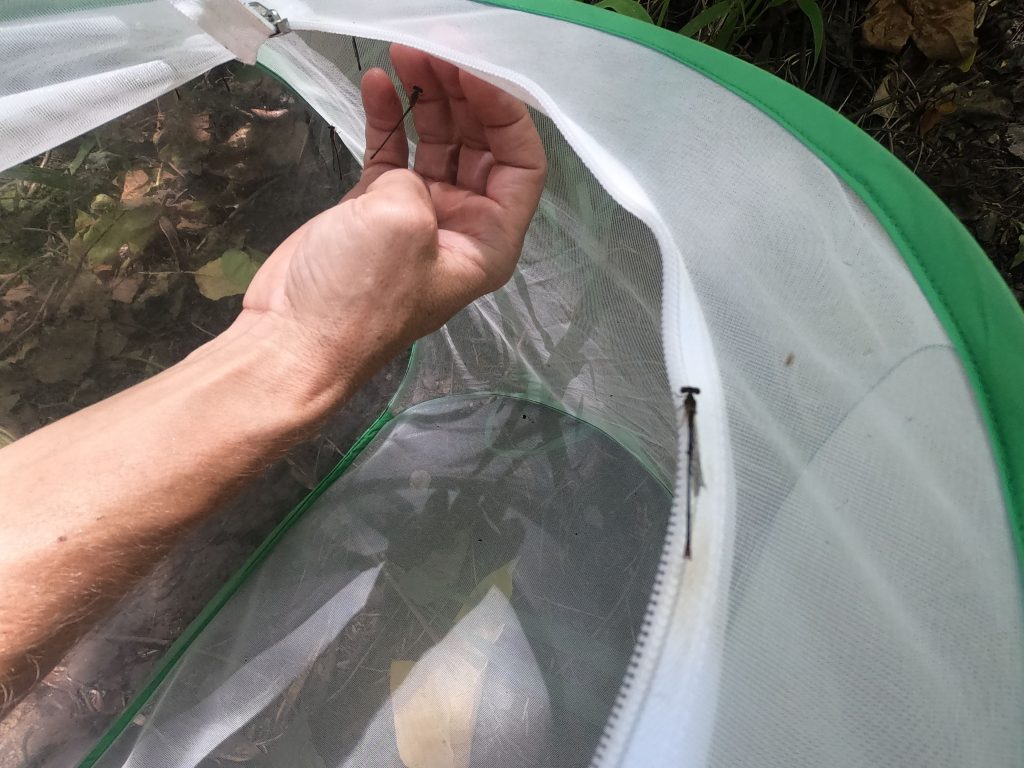Endangered Hawaiian Damselfly in Less Distress After Reintroduction on O’ahu
A small platoon of biologists and technicians walk across muddy ground, amidst shoulder-high grass to reach the point of deployment. They released an air force of orange-black Hawaiian damselflies in the bed of a small, spring-fed stream, not far from Dillingham field on O’ahu.
There is only one wild population of the 2-inch-long, native damselfly on O’ahu. That population is tucked among the buildings of the Tripler Army Medical Center’s vast campus, a difficult place to improve the lot of this endangered species.
“It’s not a super stable place for orange-black damselflies,” said Kapua Kawelo, the U.S. Army’s Natural Resources Program Manager on O‘ahu.
In the early 1990s the Army teamed up with the University of Hawai‘i to try and establish a second population of the insect at Dillingham by moving damselflies from Tripler, but that effort was not successful. More recently, the state Department of Land and Natural Resources’ Division of Forestry and Wildlife invertebrate program joined with the Army to raise the endangered damselfly in a breeding facility for introduction at Dillingham. With the development of new captive rearing techniques for the species, much higher numbers can be released.
“So far we’ve released about 4,000 damselflies reared in captivity,” said Dr. William Haines of the State’s invertebrate program. “We’re seeing the first evidence of wild reproduction at one of our release sites.”
How do they know? All the released damselflies have a small number marked on their wings.
“We’re starting to see individuals emerging from the stream that are not marked, which means they are wild born,” Haines said. “That’s really encouraging to see they’re completing their entire life cycles in the wild.”
Next month, after a full year of weekly releases, the team will stop releasing damselflies and continue monitoring the success of the program, hoping for a sustainable population at Dillingham. Both Kawelo and Haines are optimistic.
“The final test will be when we pull the plug on continual introductions from the lab,” Kawelo said.
The orange-black damselfly is a vulnerable population at the risk of extinction. It’s one of about 25 species of endemic damselflies found only in Hawai‘i, but several species have already gone extinct. The reason is another story in which a species was imported to the islands to control an invasive species, but it ended up backfiring.
Their biggest predatory threat is the mosquito fish, introduced in the early 1900s to control mosquitos. The fish feed on the immature, aquatic stage of the damselfly as well.
“Very quickly you saw damselfly populations declining after the introduction of the mosquito fish,” Haines said.
Like all native species in the fragile “circle-of-life” in the Hawaiian Islands, native damselflies play a role in the environment, providing ecosystem services. The adult damselflies prey on other flying insects, like non-native mosquitos and flies. The immatures are also predators, eating aquatic insects like mosquito larvae.
Each release of the orange-black damselfly involves 50-120 of the delicate insects. After they leave their netted enclosures, they fly off to hunt insects in the surrounding forest. Eventually, they will return to the stream to mate and lay eggs in aquatic plants.
“If we can sustain a population at Dillingham for an entire year, that is encouraging for the success of long-term populations, not only on O‘ahu, but also on other islands,” Haines said.
The orange-black Hawaiian damselfly is found in small populations on Hawai‘i Island, Maui and Moloka‘i. It has gone extinct on Lana‘i. On O‘ahu, Haines calls the future for the orange-black damselfly dire.
“Even though there are populations on other islands, the Tripler population is the single wild population left on O‘ahu and we don’t want those genetics to disappear,” Haines said.
That is why there is a race against the extinction clock. Kawelo, the Army’s Natural Resources Program Manager, concluded: “This species is one of the first I began working on more than 25-years ago. The orange-black Hawaiian damselfly was not endangered at that point, yet despite all the challenges finding a predator-free site, I’m really optimistic.”
To watch a video about the reintroduction effort, go to https://vimeo.com/546576571.














